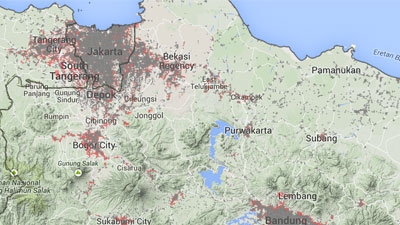- New World Bank data compiled through satellite imagery and geospatial mapping provides new understanding of East Asia’s accelerating urbanization.
- The new analysis provides vital data at a time when much of the region’s urban infrastructure is getting built as part of a physical and social transformation in East Asia.
- The World Bank report offers a blueprint for research to help governments and urban planners ensure the population shifts from rural areas to cities helps reduce poverty.
- Almost 200 million people moved to urban areas in East Asia from 2000-2010 – a figure that would be the world’s sixth-largest population for any single country.
- Indonesia has the second-largest urban population in East Asia after China – 94 million people in 2010, an increase of 28 million since 2000. The country’s urban population density is among the highest in the region which increased sharply between 2000 and 2010, from 7,400 people per square kilometer to 9,400 – the largest increase in urban population density of any country in the region.
- Despite the large amounts of new urban land in Indonesia, the country has been remarkably economical in its increase in urban land per person. The amount of new urban land added per new urban resident during the 2000–10 period was less than 40 square meters – the smallest in the region. This compares to about 135 square meters per person in Malaysia and 180 square meters in China.
- Jakarta, Indonesia’s capital is one of the region’s “megacity” urban areas of more than 10 million people. Indonesia also has two urban areas with total populations between five and 10 million (Bandung and Surabaya); 18 of one to five million; 27 of 500,000 to one million people, and 29 of 100,000 to 500,000 as of 2010.
- Jakarta is a prime example of metropolitan fragmentation. The built-up area of the Jakarta metropolitan region crosses 12 municipalities or regencies in the provinces of Greater Jakarta, Banten, and West Java.
- Population growth in the Jakarta urban area between 2000 and 2010 was higher than in any other urban area in East Asia excluding China. Jakarta’s population increased by 7 million people between 2000 and 2010. At this rate of growth (3.7% per year), the population of Jakarta would double between 2000 and 2020.
- The distribution of urban land and population across the Jakarta metropolitan region highlights the need to look beyond this core. Only 37% of urban land lies in Greater Jakarta, as of 2010, while 42% lies in West Java province.
- In the Jakarta metropolitan region, the individual municipality or regency with both the largest amount of total urban land and highest growth in urban land is Tangerang, which is in Banten province. The jurisdiction with the highest population, as well as the one with the highest population growth was Bogor in West Java (not including the municipality of Kota Bogor, which is a distinct jurisdiction).

